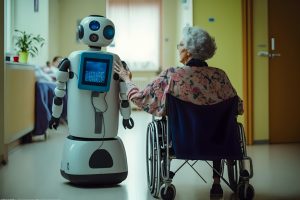 Artificial intelligence (AI) is revolutionizing industries across the board — from healthcare to transportation, investing to marketing. One perhaps unexpected area where AI shows tremendous promise is in improving the lives of older adults.
Artificial intelligence (AI) is revolutionizing industries across the board — from healthcare to transportation, investing to marketing. One perhaps unexpected area where AI shows tremendous promise is in improving the lives of older adults.
Although emerging technologies are generally associated with the younger generations, the integration of AI technologies is becoming increasingly central in a variety of tools and software that help foster independence and enhance the quality of life for older adults. From assistive technologies to companion robots, AI is reshaping the way older adults live and interact with their environments.
While there are both pros and cons to using AI technologies, the consensus is growing that these innovations have the potential to significantly improve quality of life while giving older adults the independence to age in place.
The key to success — both culturally and individually — is applying AI technologies thoughtfully and responsibly.
AI-powered Homes & Tools — Jetsons’ Style
While the internet is bursting with headlines about the arrival of the “robot overlords,” the truth is that AI technology has been in play for longer than most people realize. And while there is good reason to exercise caution, most AI applications are much more mundane than the Terminator-themed memes would have you believe. In fact, the way AI is being used today is more like the lifestyle depicted in the 1960s Hanna-Barbera cartoon series, The Jetsons.
 We may not be quite ready for robot dogs or flying cars, but here are a few of the ways that AI technology is being used today to help older adults and their caregivers on a day-to-day basis:
We may not be quite ready for robot dogs or flying cars, but here are a few of the ways that AI technology is being used today to help older adults and their caregivers on a day-to-day basis:
- Safety Monitoring: AI-powered devices, including many wearable devices, equipped with sensors can monitor older adults for changes in behavior or health. They can detect falls and even send alerts to caregivers or initiate calls to emergency services when necessary. These devices provide peace of mind to both the people using them and their families. They can also help expedite services when needed.
- Medication Management: AI technologies can assist with medication management by providing reminders to take pills and ensuring correct dosages. This helps prevent medication errors, which in turn improves overall health outcomes for older adults.
- Everyday Tasks: Smart home automation can handle a variety of daily tasks such as turning lights on and off, adjusting thermostats, and locking doors. AI can also streamline typical household tasks like making a grocery list, meal planning, coordinating transportation, and so much more. Each of these tools can help older adults maintain control over their environment, and enhance their comfort and convenience.
- Cognitive Stimulation: AI-powered games, exercises, and brain-training activities can provide cognitive stimulation that helps to maintain cognitive function and delay cognitive decline. These types of challenging and engaging activities can promote mental well-being and overall brain health.
Robots with Heart — How AI is Combating Loneliness
In addition to assisting with daily tasks, some companies are developing AI-powered technologies to combat the loneliness that is often prevalent among older adults. One such example is the ElliQ robot, designed and developed by Intuition Robotics.
ElliQ was designed to be a companion that provides older adults with conversation, games, and even emotional support. While these kinds of interactions may seem frivolous on the surface, they can be a critical component of overall health. Robots like ElliQ can provide companionship and reduce feelings of isolation. As reported by AP News, older adults who interact with ElliQ experience increased social engagement and improved mental well-being.
83-year-old Deanna Dezern had this to say about ElliQ in the AP article, “It was so what I needed. I can say things to Elli that I won’t say to my grandchildren or to my own daughters. I can just open the floodgates. I can cry. I can giggle. I can act silly. I’ve been asked, doesn’t it feel like you’re talking to yourself? No, because it gives an answer.”
Doing AI Right
 As we embrace AI technologies to help improve our golden years, it’s crucial to consider both the broader cultural and ethical implications, and an individual’s unique personal circumstances.
As we embrace AI technologies to help improve our golden years, it’s crucial to consider both the broader cultural and ethical implications, and an individual’s unique personal circumstances.
On the cultural level, the World Health Organization’s recent policy brief, “Ageism in Artificial Intelligence for Health,” highlights the importance of addressing ageism in AI design and implementation. The brief outlines eight considerations to ensure that AI technologies for health effectively combat ageism, and emphasizes societal responsibility in leveraging AI for older adult care in an equitable way. This approach aims for a future where technology enhances lives while promoting inclusivity and compassion.
On a personal level, there are a number of best practices you can follow to ensure your loved ones get the most benefit from AI technologies:
- Get Personal: Everyone has different needs and different levels of comfort with technology. For best results, you should look for ways to customize AI solutions to meet your loved one where they are. This includes understanding and respecting privacy concerns and other issues that might make some older adults uneasy.
- Be a Good Teacher: The key to successful adoption of new technologies is taking the time to provide thorough education and training on how to use AI devices effectively. Patience is critical here.
- Introduce a Little at a Time: While we’ve seen that there are many ways AI can help domestically and socially, resist the temptation to throw everything and the kitchen sink into the mix at once. It’s far better to introduce AI technologies gradually. This allows new users to adapt at their own pace, which will greatly improve the chance that they’ll stick with the new tools.
- Maintain Open Lines of Communication: Encourage open communication between your loved ones, their caregivers, and even professional medical staff on the topic of AI. These conversations should provide an opportunity to address concerns, share what’s working and what’s not, and optimize the use of technologies in a way that suits everyone involved.
- Keep It Real: There are lots of things AI can do really well, but being human isn’t one of them. AI should never be used to replace human interaction or care. AI is a complementary tool that can support the broader network of human-based support. So, while AI can be used to do things like automate tasks and streamline communication, it’s more important to center the human connection in any care experience.
Aging with AI
The whimsical 2012 movie, “Robot and Frank,” starring Frank Langella as Frank and Peter Sarsgaard as the Robot, tells the story of the unlikely friendship between a retired jewel thief with luddite tendencies and the robot companion Frank’s kids forced on him. While ElliQ and similar AI entities are still a far cry from the would-be heist accomplice in “Robot and Frank,” we seem to be moving ever closer to a world where such relationships might be possible.
Though many may still balk at AI technologies, we cannot overlook the many possibilities for improving the lives of older adults. From enhancing safety and security to providing companionship and cognitive stimulation, AI offers innovative solutions to age-related challenges. By embracing AI technologies thoughtfully and responsibly, we can empower older adults to live more independently, age more gracefully, and enjoy a higher quality of life in their golden years. Used well, AI can help us create a world where aging is not a barrier but an opportunity for growth and enrichment.
Related Posts:
Make Life Easier with Technology: 5 Tools to Look Forward To
A Whole New World: The Future of Senior Housing
Estate Planning from Home: Video Conferencing is Easier Than You Think
 Connecticut Estate Planning Attorneys Blog
Connecticut Estate Planning Attorneys Blog


